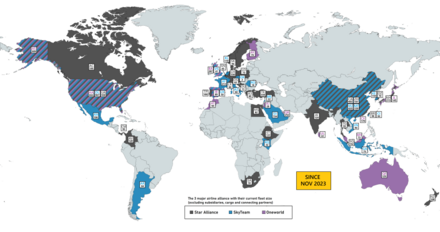
Back تحالف خطوط الطيران Arabic تحالف خطوط الطيران ARZ Alianza aérea AST Aliança d'aerolínies Catalan Aliance leteckých společností Czech Luftfartsalliance Danish Luftfahrtallianz German Αεροπορική συμμαχία Greek Flugkompania alianco Esperanto Alianza aérea Spanish

An airline alliance is an aviation industry arrangement between two or more airlines agreeing to cooperate on a substantial level. Alliances may provide marketing branding to facilitate travelers making inter-airline codeshare connections within countries. This branding may involve unified aircraft liveries of member aircraft.[1]
In 2015, Star Alliance was the largest with 23% of total scheduled traffic in Revenue passenger kilometres (RPKs)/revenue passenger miles (RPMs), followed by SkyTeam with 20.4% and Oneworld with 17.8%, leaving 38.8% for others.[2] In 2019, by number of passengers, Star Alliance was leading 762 million,[3] followed by SkyTeam (630 million)[4] and Oneworld (535 million).[5]
- ^ Fernandez de la Torre, Pablo E. (1999). "Airline alliances : the airline perspective". DSpace@MIT. hdl:1721.1/68159. Retrieved April 15, 2014.
- ^ "Scheduled Passengers Carried". World Air Transport Statistics 60th Edition. IATA. Archived from the original on 2016-07-06. Retrieved 2016-07-11.
- ^ "backgrounder". Star Alliance. 18 Oct 2019. Archived from the original on 22 December 2019.
- ^ "Fact Sheet" (PDF). SkyTeam. 2019. Archived (PDF) from the original on 2019-08-29.
- ^ "20 years, 20 facts, oneworld". OneWorld. 2019-02-01. Archived from the original on 2019-11-30. Retrieved 2019-12-22.
© MMXXIII Rich X Search. We shall prevail. All rights reserved. Rich X Search